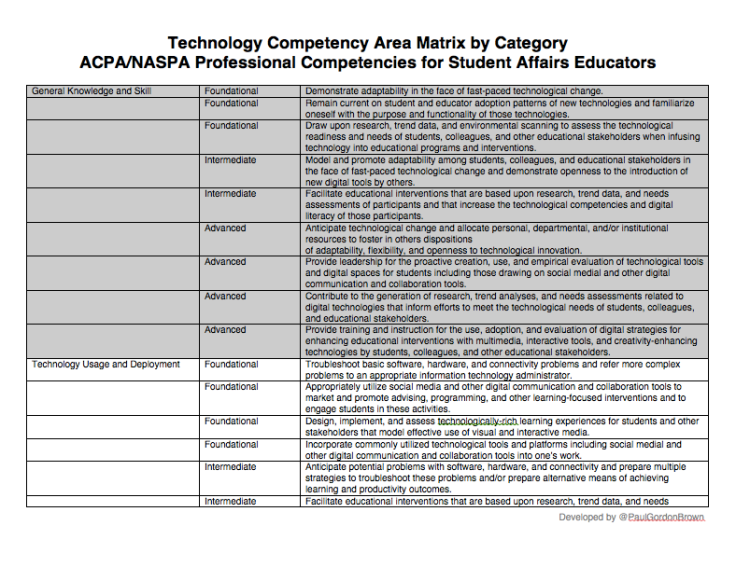This series delves deeper into the new Technology competency recently added to the ACPA/NASPA Professional Competency Areas for Student Affairs Educators. Intended to serve as a resource for faculty and professionals to guide professional development and teaching, it provides a deeper understanding of the topics covered in the competency and provides resources for further education.
- Part 1: Overview
- Part 2: Themes
- On Professional Competencies and the Student Affairs Philosopher King
Also check out Josie Ahlquist’s series for an excellent alternative take on the topic.
In the previous post, I provided an overview of the Technology Competency Area as well as some of the reasoning behind why this area was “upgraded” from a thread present throughout all of the areas to an area in its own right. In this post, I wanted to delve more deeply into the competency and the individual outcome statements that comprise it. The competency outcomes are organized into three levels: Foundational, Intermediate and Advanced. As represented in the graphic below (pulled directly from the competencies document) increasing competency in these areas results in greater integration and cross-area synergies.
Within the Technology Competency Area one can find similar types of movement. At the foundational level, many outcomes begin with verbs such as “demonstrate,” “model,” and “ensure.” Moving towards the advanced outcomes reads like Bloom’s Taxonomy. At the advanced level the verbs change to “lead” and “provide.” At the advanced level, professionals are often working on “systems” and the broader planning work that enables others to apply foundational and intermediate skills towards the achievement of ends. In my own experience as a Dean, this shift makes sense as I was supervising individuals enacting some of the foundational and intermediate outcomes while I focused on enabling their work by focusing on the systems they used and on removing institutional barriers.
Classifying the outcomes statements by level is one way of organizing them, but I believe it may be helpful to go one step further and identify themes or categories into which these outcome statements fit. Understanding the outcomes in this way can help with the creation of more focused professional development and curricular efforts to achieve them. After reviewing the outcomes under the Technology Competency, I identified eight main themes that emerged:
- General Knowledge and Skills – Knowledge about general trends and research into technology and its applications.
- Technology Usage and Deployment – Using technology tools and applications and planning for its deployment to achieve goals and ends.
- Digital Media Literacy – Critically examining and using digital data sources.
- Data Security – Ethical use of and protecting sensitive data and educational records.
- Equity and Inclusion, Universal Design, and Accessibility – Universal access to technology and using technology to enhance access.
- Digital Reputation – One’s own and other’s identity, reputation and behavior online.
- Professional Development – Technology as a means of facilitating professional development and education.
- Development, Learning, and Assessment – Using technology to address developmental and learning needs.
A few thoughts about these themes. Although all of the themes have foundational, intermediate and advanced level outcomes identified, I do not believe that this necessarily has to be the case. It’s distinctly possible that some themes might not come into play until one reaches an advanced stage or that some may be present at a foundational level and yet have no analogous outcome at the advanced level.
The themes I identified that I am least happy with are the first two: “general knowledge and skills” and “technology usage and deployment.” They function much more like catch-all for “what you need to know” and “what you do” with technology. Within these there are some additional themes such as “marketing” and “research” that may be separable stand alone themes. (If you have suggestions, please leave them in the comments!)
To help professionals dive deeper into the competency, I’ve created two documents (below) that are organized by outcome and theme. It is my hope that this might help professionals begin to make sense of the competency and utilize it as a tool for more focused planning.
The following document (click here or below) provides a matrix with each outcome, listed in order by level, and X’s indicating which of the themes the outcomes falls under:
The next document (click here or below) presents the same information as the one above, but lists the outcomes (in order) by theme. You’ll notice that some outcomes appear more than once in the document under different themes:
Some questions to ponder…
- How might you organize these outcome statements? What themes would you identify?
- Are there sub-themes present within the two biggest themes I identified (General Knowledge and Skill, and Technology Usage and Deployment)? Perhaps marketing is a sub theme? Interpreting and using data? Visual and interactive media?
- How would you rate your competency in each of the thematic areas identified?


